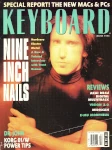
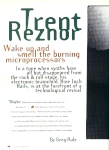
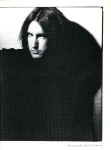
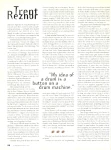
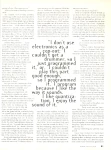
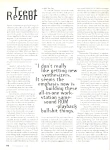
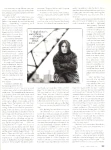

Wake up and smell the burning microprocessors
-By Greg Rule
In a time when synths have all but disappeared from the rock & roll stage, his electronic brainchild, Nine Inch Nails, is at the forefront of technological revival. Maybe keyboards are considered unfashionable these days, but I don't give a f ..." Trent Reznor isn't one to mince words. Since bursting onto the scene in 1989 with his Nine Inch Nails platinum debut Pretty Hate Machine, he's proceeded to shock, offend, and, yes, amaze us with his twisted brilliance. In his hands, vintage synths, guitars, and raw samples become harsh, yet ingeniously crafted electro-metal landscapes. Once-recognizable instruments are digitally stomped, scratched, and mangled into noisy byproducts using Digidesign Turbosynth and other, more fiendish sample-editing techniques - ultimately to be layered with Reznor's own tortured voice. Even though he makes no bones about his hi-tech allegiance, Trent Reznor has surged to the forefront in a technology-hating genre. "I think keyboards have been given a bad rap in rock music," he says with disgust. "The Pearl Jams and whoever, that's not what I'm about. I like keyboards. I like technology. This is who I am." In mid-1992, after a real estate deal in New Orleans fell through, Reznor flew to L.A. in hopes of finding the ultimate home studio site. And boy did he ever... the infamous "Charles Manson" Tate mansion. Considering his affinity for things abnormal, the match wasn't too surprising. What was surprising was the fact that he picked the place unknowingly. "On a whim, I came out to Los Angeles," he says, sprawled across a sofa at the Record Plant in Hollywood. "It was a whirlwind tour: I looked at maybe 15 houses in one day, and at that time I had no idea one of them was the Tate house. No one brought that to my attention, even though they should have." After closing the deal, and driving halfway across the U.S. from his digs in New Orleans, Reznor wasted little time in transforming the spooky confines into a high-tech showcase. Rooms that once witnessed the deeds of Sir Charles were now home to a new breed of dementia. The Downward Spiral (Interscope), the result of his Tate tenure, is aggressive, rude, inventive, and unpredictable. The lyrics are cold, and packed with references to such items as pain, sex, and disease. From the opening cut, "Mr. Self Destruct," a jagged aural assault reminiscent of "Wish," to "Closer," an electrogroove laden with 808 drums and watery bass lines, Reznor's vision is distorted, unnerving, and altogether brilliant. "This was a difficult record to make," he grimaces. "I didn't have a definite idea of how it should sound. I mean, I had a theme lyrically and vibe-wise, but musically I wanted to put more emphasis into textures and mood, and not rely on the same bag of tricks. I had to develop a whole new palette of sounds to work with. "Another thing that delayed this record was me learning how to write again," he continues, "deciding what I wanted to do. I didn't want to make another Broken [Interscope]. I didn't want to box Nine Inch Nails into: 'Make every song harder than the last one, meaner, tougher.' I think that's a trap. That's not really what Nine Inch Nails is about. And I didn't want to go completely back to the Pretty Hate Machine style: percolating synth stuff. But I realized that when I sat down and started noodling around with ideas, I was much more inspired to sit at a keyboard than I was with a guitar." A closet noodler Reznor isn't; he was classically trained on piano as a kid. And even though he doesn't like tooting his own horn, his studio chops aren't too shabby either. As a teen, he logged time as an employee of a Cleveland, Ohio recording facility, an association that ultimately lead to the formation of Nine Inch Nails. Those unfamiliar with Reznor's past work might want to check out his hellish electronic stylings on Pretty Hate Machine and its six-song follow-up, Broken. "With Broken," he explains, "I wanted to do something a lot harder than I did on Pretty Hate Machine. I wanted it to be a blast of destruction." Broken was made in secret because, according to Reznor, "we were in the midst of a legal tangle with TVT, our old record label." His signing to TVT (a.k.a. TV Toons, the company that brought us soundtrack compilations from the likes of Gilligan's Island), served to launch Nine Inch Nails' music. But in retrospect, the pairing of personalities couldn't have been more disjointed. Today, Reznor is all too ready to kiss the studio world goodbye and get back to the altered reality of life on the road. A tour of Europe kicks off in April, followed by an extensive swing through the States. Keyboard spent a day with Reznor at the Record Plant recently and learned firsthand about the aches, pains, bumps, and bruises associated with a do-it-yourself record. Why did you decide to make this record at home? The project took considerably longer than anticipated. What happened? Were there many gear snafus or other problems associated with working at home? What were some of the things you sampled? Let's get into the components of the record. Your drum tracks sound like a mixture of machines, samples, and maybe a bit of live drumming. Did you use drum machines? Toward the end of the song "Piggy," it sounds very much like live drumming. How much of this album was recorded to hard disk? Did you mike the guitar cabinets or go direct? What are those "key ingredients" in Turbosynth you mentioned a minute ago? What are the roles of your various synths and samplers? The bass sound on "The Becoming" was impressive. You mentioned having difficulty with your synchronizer. Did you have any similar problems keeping your synths, samplers, and hard disk tracks in line? What was it like working with Flood? In addition to the familiar NIN suspects, did you collaborate with any other outside artists? How are you going to pull this music off live? Did you ever feel inhibited, improvisation-wise, by using tapes? What will the lineup be for this tour? Are you planning to take an ADAT, DA-88, or whatever, on tour this time? Care to expound upon any of those hellish gig experiences? So what did you do?
I wanted to fine-tune my engineering skills; that's one thing we've always lacked in the Nine Inch Nails inner circle. I figured if I had a studio around, I'd inevitably figure out how to do it. And also, for the first time, we had the resources to do something right, so we ended up buying a big console and a couple of Studer machines because it was cheaper than renting, in the long run.
We moved out here [to L.A.] on July 4, 1992. What we thought would take X amount of time to get a studio set up, ended up taking three times as long. As much as I enjoy equipment, fucking around with stuff, systems, and all that, there came a point where the whole focus was just to get the damn thing working and then learn it. Eventually I realized, "Okay, I'm sick of being in this room, now it's time to write an album." So I started writing, and by Christmas I had about four songs that I thought were decent.
There were a couple pieces of gear crucial to the way the studio worked up at the house. One of them was a [Timeline] Micro-Lynx synchronizer. It syncs the two Studers, [Digidesign] Pro Tools, and everything. To be honest, it didn't work. Ten times a day we'd have to turn it off, unplug every cable, plug 'em back in, turn it back on, call the company, and, "Guess what? It doesn't work." There were many times when I thought, "Am I the only person in the world who's ever tried to hook these two pieces of gear, that they say work together, together?" So between that, and the terrible automation on the Amek board that we had, things would grind to a halt. I cannot tolerate equipment fucking up when you're trying to write a song, when you're on a roll. When you're in a [commercial] studio and something breaks, someone is usually there to fix it. When you're in a house, you're lying on your back under the board, scratching your head, trying to figure what the fuck. I mean, we can get people, but it might mean five hours of waiting around.
One danger when having a full studio in your house is: What do you focus on? I could spend, and have spent, a month just sampling things. So now, when it comes time to pull up a drum bank, it's all cool sounds that I've created, rather than leftovers from things I've used before. We spent a lot of time sampling and processing the sounds through different things. That way, when the actual writing and arranging moment came ... when you went to reach for that bank of sounds, they were inspiring, instead of, "Fuck, I'm in the middle of writing a song, but I should really spend a couple of days getting all new Oberheim sounds."
My assistant, Chris Vrenna, probably went through 3,000 movies, listening to them without watching them. Not to find the cliché spoken dialog sample, but just to hear sounds. He'd throw them on DAT, then I'd listen to them - I didn't know where they came from - and I'd cut 'em up into little segments and process them further through Turbosynth or whatever. We compiled almost ten optical discs of "things" like that. We'd do a new song: "Okay, what's the mood?" "It's grim." So we'd put up a bank, find a sound, and set it aside.
Another thing I did was ... a guy came to tune our studio, and he had one of those real-time frequency/noise-generator things. So I sampled it. I think there's something strangely musical about noise. If you take a high frequency, and pitch it way down to where it's aliasing, you've got a pretty cool thing. You layer that into the mix and it suddenly becomes thicker, even though sometimes you can't necessarily hear it. A song like "Mr. Self Destruct," obviously you're going to hear it; it sounds like a vacuum cleaner running through the whole thing. But a lot of times it just thickens things up without being noticed as, "Oh, he's layering some noise in there."
Everything was programmed. My idea of a drum is a button on a drum machine. When I hear a real drum kit ... when someone hits a kick drum, it doesn't sound to me like what I think a kick drum is. Any time I've been faced with, "Let's try miking up the drums," well, you put a mike up close, you put another one here, 300 mikes, gates, bullshit, overheads, bring 'em up and listen to it and it doesn't sound at all like it did in the room. It sounds like a "record-sounding drum kit." It doesn't sound like being in the room with live ringy drums. You read these interviews where producers will say, "It sounds like you're in the room with the band." No it doesn't. Nirvana's record doesn't sound like you're in the room with them. It might sound sloppy, and it sounds interesting, but it's not what it sounds like in the room, to me, anyway.
So we were experimenting with just two mikes, PZMs usually. We ended up taking a drum kit into about 25 different rooms - from sneaking into live rooms at A&M Studios to bathrooms to living rooms to a garage, outdoors. We didn't close-mike anything, just put mikes in the same position about the same distance away from the drums, then hit each drum at several velocities and recorded them on a DAT machine. Then we sampled them all in stereo with velocity splitting on the Akai S1100s. I noticed that when you sat down and played those on a keyboard, they sounded exactly the way they did in the room: shitty, ring, you know. When I programmed them, and even when they were perfectly quantized, they didn't sound like a drum machine. And that, in itself, lent a strange, unexpected vibe to the thing. So on a few songs, we used that. I purposely made the drum programming very rigid, so that maybe someone will listen to it and think, "Is that a machine? Nah, can't be. No machine sounds that shitty." I like the idea of hearing a record and thinking, "That's guitar, bass, and drums," and then upon further inspection, "Wait a second, that's not what it appears to be." So that was one thing we did. And then sometimes, it was cool to say, "Well, let's see what those drums would sound like in the bathroom." So we'd load a different disk and use it with the same sequence.
Well, we sampled a Roland TR-808, as you have to these days. I try to avoid using it, but there's something about that low end. It's hard to beat that great low 808 kick. Actually, for "Closer," we sampled the kick drum off of an old Iggy Pop record, "Nightclubbing," off Idiot. Most everything was sampled, but I did use a Roland R-70, just because I wanted something that was a drum machine. I ended up being pretty impressed with its sounds, although they're somewhat generic-sounding. Good idea but terrible operating system.
Okay, I confess, that one thing was live. For that part, I had a rigid, weird sixteenth-note pattern going. A kit was set up in the dining room, and I was playing along, fuckin' around, testing out the drums. I'd go in the other room, start the machine, run back in, put the headphones on, and play along. I couldn't hear it very good and I was way out of meter. So I just played as insanely as I could so I could hear how the drums were going to sound on tape. When I listened back, I thought, "Hey, that's pretty cool. Someday I'll come back and fix it." And of course I never did. That was it. That was the final take. A lot of what I do is accidental. I luck into things. I think that due to laziness - not coming back and fixing things - they end up becoming more interesting. My instinct is to repair, edit. "I'll get to it later." But then I'll get so used to hearing it, I'll end up leaving it alone.
Pretty much any real instrument like guitar or vocals or bass was recorded into the computer first; I use Opcode's Studio Vision all the time now for sequencing. Usually I'd loop something and then play along with it for awhile, then I'd go back and listen. If anything was decent, I'd cut it together into something cool. All the guitars I played were cut up and put together like that.
I never mike cabinets. I've tried it, but I just don't like the sound that much - versus just going direct or through amp simulators. Broken, for example, had a lot of that super-thick chunk sound. Almost every guitar sound on that record was me playing through an old Zoom pedal, direct, and then going into Turbosynth. Then I used a couple of key ingredients to make it sound unlike any real sound in the world, and layered about four of them together. By then, it wasn't a guitar anymore. It's an awesome sound.
The great thing about the guitar as an instrument is its expression. It's much more expressive than playing a keyboard. Unquestionably, the controller/input device of the strings is a lot more expressive and accidental and uncontrollable. When you then can take that, and process it in a computer environment, you still get some of those elements of randomness.
Usually I call up the Waveshaper and click through a few of them, or "convert sample to oscillator" sometimes. A real low pitch can get you some insane sounds. I also use the modulator: Taking the sound as one input, getting the oscillator module, taking something with a real low frequency that has a bell tone or some odd harmonics, and modulating those two can usually produce some awesome death vocal or guitar sounds.
Also, for guitar, almost everything was put through a Zoom 9030. I don't like the distortion stuff in there - it's too traditional-sounding - but I really like the amp simulator. We also have the new Marshall rack-space head, the JMP-1 I think it is. It's a great-sounding head. So I take the direct out of that through the amp simulator in the Zoom, and you can get a pretty good, almost Pantera-ish power metal sound. I use that as a basis to start with, and since everything's recorded in the computer, it's easy to take it into Turbosynth and fuck around with it. Sometimes in real time, too. With [Digidesign] Sound Tools, I'll mess around in the parametric EQ window in real-time when it's previewing. It's also outputting digital at that time, so I'll hook a DAT up and record it while it's previewing, sweep through stuff, and get some insane distortion stuff. Load that back into Studio Vision and you have a performance of an EQ thing that you couldn't do otherwise. We do a lot of stuff like that.
For "Mr. Self Destruct," we ran the whole mix through some old Neve mike pre's: a couple of channels of an old board. Those have great distortion; they're what I use for vocal distortion on almost everything. Those and the Zoom, which has a great ring modulator. I will say, though, that vocal distortion has become an incredibly cliché thing these days. It's become overused and uninteresting. But I think there are varying degrees of blending it in, or different effects that can come across. I want people to hear what I'm saying, but then again, I'm not interested in the great Phil Collins vocal sound. Maybe it's because I'm insecure about my own vocals. I don't know. But it's my record, and I'm gonna make it sound shitty if I want to.
Most everything is Akai samplers. I think the best thing about having some amount of success is the ability to get cool gear ... not being bummed when some new sampler comes out that you know you can't afford. So we have two S1100s, each one with an expander, so essentially four samplers. And that works out perfectly: One's almost always used for drums, one for miscellaneous stuff, and so forth, with quite a bit of memory in each one. Then it comes down to ... I use the Minimoog a lot. I don't really like getting new synthesizers. It seems the emphasis now is building these all-in-one workstation same-sound ROM-playback bullshit things. I really kind of fell out of touch with what was happening until someone suggested I check out a Kurzweil K2000, which I did, and bought. I think that's the only keyboard I've bought recently that's new, that I think is potentially awesome. I don't know all I should know about it, but we used that a lot because of the fact that it can read Akai banks. To me, that's kind of like real-time Turbosynth that's MIDI-controllable in a sampling situation. So we'll take a drum bank from the Akai, load it into the Kurzweil, and set up the programmable sliders on my MIDI controller to control some parameter that modulates something. On the song "The Becoming," all the drums were done with the Kurzweil like that. You could never do that in the Akai. I was also surprised at the amount of shit that's in there. In the day of preset piano sounds, it's incredible that someone put that much thought into an instrument.
That was the "Ober-Moog," or whatever it was going to be called. I got it from Richard Bugg, my repair guy out here who was one of the guys designing it. I asked him, "Have you heard about this Oberheim-Moog thing?" And he says, "Yeah, I've got one out at the house. Wanna borrow it for a while?" "Bring it on over!" That thing is the fuckin' greatest-sounding keyboard in the world, because it sounds like a Minimoog and an Oberheim, and you can run each one through each other. It doesn't quite work right, and unfortunately the project was scrapped, but that's what I used. It shows up in a couple of places mainly because I was getting bored using the Minimoog, which I've used for almost every bass sound I've ever done. So now I use the Minimoog a lot more for running stuff through its external input and through the filter. Aside from that, I still use the Oberheim Xpander, but it's role has decreased a little bit; I'm just kind of bored with it. And the Prophet-VS, I still use that. I had a PPG when they were out, and I have a Waldorf MicroWave now. If I go about trying to program that thing in a logical way, it comes out sounding like mid-1980s synth-pop - kind of dated, digital-sounding. But just through randomly generating stuff with Opcode's Galaxy, and I did this a lot on the Xpander and the VS, I'd generate thousands and thousands of programs. Then I'd hear an element of one that was cool, and fine-tune it. That may be a cop-out way of programming, but it was pretty interesting to find out, "What the fuck did it do to make it sound like that?" Then you go in and look and see what it did randomly. Every patch I have in the Waldorf is from that origin.
Not too much, really. Studio Vision was great - very few hassles keeping stuff together, in that respect. But we're not too anal about ... if something is happening, we'll try to work around it. We'll figure out how to fix it later. We do a lot of stuff really sloppy on certain levels. On other levels, it's a very laboratory-like environment.
But problems? Sometimes I'd be in the studio and discover; "Why are all the vocals I've recorded suddenly in the wrong pitch and out of sync?" Then you realize that tape calibration somehow got turned on in Studio Vision - some mysterious element that changed the pitch and the tempo of the sequence and . .. it's gone, you'll never get it back at that point. You can diddle around with equations, pitch-shift everything down, slow it down X amount. Forget it. Go have a beer, come back the next day, and start over.
Flood is an awesome guy, the best programmer I've ever been around in my life. You tend to work a certain way, which is very methodical - chisel away. "The completion of your record is so far away, don't even think about it. Just think about the completion of this hi-hat program." Then I read where Nirvana recorded and mixed an album in two weeks, and I'm going, "Fuck, that's gonna sell a lot more than mine is." There's got to be some balancing. So the next record I'm gonna do is going to be one that's a lot more spontaneous. One that better hides the horrors of technology, which can bog you down to a crawl. Many a time I've been sitting in front of an Akai with its ridiculous, archaic operating system trying to put these 400 samples into this keygroup and . . . "Why am I doing this? This is stupid. Why haven't I hired someone to do this for me yet?" That's another thing that led to the delay in putting out this record: getting bogged down in the studio. "There are 40 things I could do right now. I could write a song, which is the most important, or I could sample drums, or I could try EQing this, or programming that," and so on. It's lacking the discipline and focus to say, "Forget all the fun stuff. I'm going to sit down and write a song."
We had [guitarist] Adrian Belew come in just to see what would happen. He showed up, and, "Hi, what do you want me to do?" And Flood and I were like, "Well, we don't know." So he looks at us, scratches his head, "All right, what key is it in?" We look at each other, "Hmm, not sure. Probably E. Here's the tape, do whatever you want to do. Go!" So he started noodling around and ... Adrian is the most awesome musician in the world. I've never seen anybody play guitar like that.
Well, the thing I learned from the last tour . . . the dilemma that I faced was: I didn't want to have three guys onstage, faking everything, with a tape machine running. However, I also didn't want a seven-piece rock band where every cool bit of electronic-ness was converted into people approximating it live on other instruments. I don't use electronics as a cop-out: "I couldn't get a drummer, so I just programmed it," or, "I couldn't play this part good enough, so I programmed it." It's not that kind of thing at all. I program because I like the way it sounds. I like quantization. I enjoy the sound of it. I like using those elements of perfection amidst randomness. And live, I didn't want that element to be brushed under the table by a big live band. So we used four tracks of tape and four musicians: I'd play guitar on some songs, and sing, plus a keyboard player, a guitar player, and a drummer.
At the time there were no digital four-track devices that were affordable to us, so we just used a four-track cassette deck - high-speed Tascam special. One track would be a click that the drummer would play to; he'd wear headphones onstage. One track would be bass, because 90 percent of the bass was synth, and I wouldn't want a real guy playing a bass, simulating that, nor would I want to see a keyboard player tapping sixteenth-notes out with his head down. And the other two tracks were stereo miscellaneous. Maybe it would be a percussion loop. Maybe it would be some sequency-sounding keyboard part. Stuff like that. And all the drums, vocals, main keyboard parts, and guitars were being played live.
I don't feel like I have to justify why we used tape onstage - I've always admitted that, and I will admit that we're going to do it again on the next tour - but the point was, that was the best way to get the stuff across live. That was the best way to maintain what was good about the electronic side of it. I didn't want to take sequencers and shit out live: "Excuse me, ladies and gentlemen, while I get on my back and get under the keyboard rig and figure out what MIDI cable isn't plugged in." I mean, we had enough problems with the one piece of gear that can fuck us up: the tape deck. We had a lot of problems with that. The only MIDI onstage was from triggers on the drum kit. The keyboard player just had an [E-mu] Emax; he'd load a disk for each song.
Obviously you can't extend the end of a song, but I've never done that anyway, so I don't miss it.
Since we never played most of the Broken stuff out live - which is way heavier on guitar, and I don't want to be bogged down playing complicated guitar parts and singing - I've got Chris Vrenna on drums, James Wooley on keyboards, and two new guys, Danny Lohner and Robin Finck, each of whom is a guitar player/keyboard player/bass player. They're the best musicians I've had involved in the band so far. I even foresee moments when everybody is playing keyboards onstage.
Yeah. That's the plan right now. We're testing both kinds to see which one is more roadworthy. But essentially, my band can play more now, so the decision to move to eight tracks is based purely on the fact those machines are digital and available, and not because we necessarily need more tracks. I mean, we are going to experiment with some things like putting timecode on it, and we're orchestrating a production where some cues could be timecode-based to some lighting stuff. Not a totally automated light show, but there could be things ... this is all hypothetical, but we're talking about some back speakers for surround things where a couple of tracks on the tape could be used for certain effects. One thing is certain: I'll never go back out with a fuckin' Tascam cassette deck which has the irritating problem of stopping whenever there's a voltage spike or anything. That has led to a few problems with us onstage.
Opening day, Lollapalooza, Phoenix. We couldn't play because one of the power boxes had melted, and every time the low end of the P.A. would rumble, it would jiggle the cord and all power onstage would just shut off and turn back on. If you have a sampler, that means you're down for a minute. And if you have a tape deck, ahem, that means it stops. But I think because we were an "electronic" band, everyone was just waiting for us to fuck up onstage. So this started happening and: "Hello, does anybody know what's going on?" A voice from backstage: "No, but I think it's working now." Turn to the crowd: "Okay, hey; we suck, so here's our next song." And ten seconds into it, every time he hit the kick drum, there it went. Turn back around: "This is the biggest show we've ever played, does anyone know what the fuck is wrong?" Voice from backstage: "We think we have it!" Turn to the crowd: "Okay, one more time," and ...
We smashed all the gear and ran to the bus.